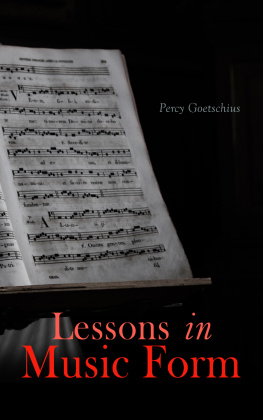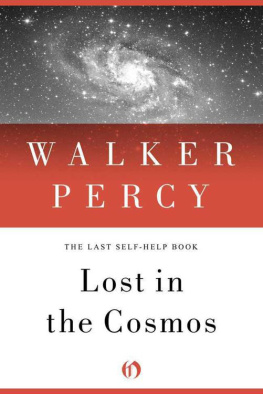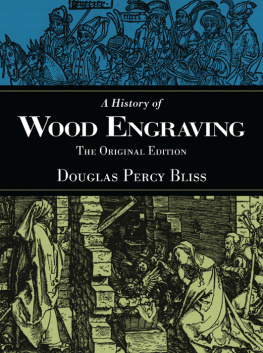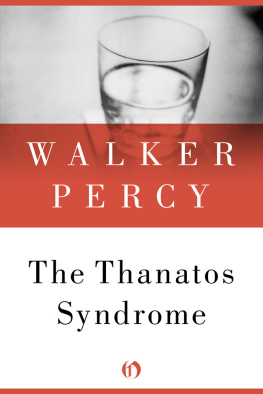Percy Goetschius - Lessons in Music Form
Here you can read online Percy Goetschius - Lessons in Music Form full text of the book (entire story) in english for free. Download pdf and epub, get meaning, cover and reviews about this ebook. year: 2020, publisher: e-artnow, genre: Children. Description of the work, (preface) as well as reviews are available. Best literature library LitArk.com created for fans of good reading and offers a wide selection of genres:
Romance novel
Science fiction
Adventure
Detective
Science
History
Home and family
Prose
Art
Politics
Computer
Non-fiction
Religion
Business
Children
Humor
Choose a favorite category and find really read worthwhile books. Enjoy immersion in the world of imagination, feel the emotions of the characters or learn something new for yourself, make an fascinating discovery.
- Book:Lessons in Music Form
- Author:
- Publisher:e-artnow
- Genre:
- Year:2020
- Rating:4 / 5
- Favourites:Add to favourites
- Your mark:
- 80
- 1
- 2
- 3
- 4
- 5
Lessons in Music Form: summary, description and annotation
We offer to read an annotation, description, summary or preface (depends on what the author of the book "Lessons in Music Form" wrote himself). If you haven't found the necessary information about the book — write in the comments, we will try to find it.
Lessons in Music Form — read online for free the complete book (whole text) full work
Below is the text of the book, divided by pages. System saving the place of the last page read, allows you to conveniently read the book "Lessons in Music Form" online for free, without having to search again every time where you left off. Put a bookmark, and you can go to the page where you finished reading at any time.
Font size:
Interval:
Bookmark:
Contact:
The present manual treats of the structural designs of musical composition, not of the styles or species of music. Read our AFTERWORD.
It undertakes the thorough explanation of each design or form, from the smallest to the largest; and such comparison as serves to demonstrate the principle of natural evolution, in the operation of which the entire system originates.
This explanationbe it well understoodis conducted solely with a view to the Analysis of musical works, and is not calculated to prepare the student for the application of form in practical composition. For the exhaustive exposition of the technical apparatus, the student must be referred to my "Homophonic Forms."
The present aim is to enable the student to recognize and trace the mental process of the composer in executing his task; to define each factor of the structural design, and its relation to every other factor and to the whole; to determine thus the synthetic meaning of the work, and thereby to increase not only his own appreciation, interest, and enjoyment of the very real beauties of good music, but also his power to interpret, intelligently and adequately, the works that engage his attention.
The choice of classic literature to which most frequent reference is made, and which the student is therefore expected to procure before beginning his lessons, includes:
The Songs Without Words of Mendelssohn; the Jugend Album, Op. 68, of Schumann; the pianoforte sonatas of Mozart (Peters edition); the pianoforte sonatas of Beethoven.
Besides these, incidental reference is made to the symphonies of Beethoven, the sonatas of Schubert, the mazurkas of Chopin, and other pianoforte compositions of Mendelssohn, Beethoven, Chopin, and Brahms.
PERCY GOETSCHIUS.
BOSTON, MASS., Sept., 1904.
THE NECESSITY OF FORM IN MUSIC.So much uncertainty and diversity of opinion exists among music lovers of every grade concerning the presence of Form in musical composition, and the necessity of its presence there, that a few general principles are submitted at the outset of our studies, as a guide to individual reflection and judgment on the subject.
Certain apparently defensible prejudices that prevail in the minds of even advanced musical critics against the idea of Form in music, originate in a very manifest mistake on the part of the "formalists" themselves, who (I refer to unimpassioned theorists and advocates of rigid old scholastic rules) place too narrow a construction upon Form, and define it with such rigor as to leave no margin whatever for the exercise of free fancy and emotional sway. Both the dreamer, with his indifference to (or downright scorn of) Form; and the pedant, with his narrow conception of it; as well as the ordinary music lover, with his endeavor to discover some less debatable view to adopt for his own everyday useneed to be reminded that Form in music means simply Order in music.
Thus interpreted, the necessity of form, that is, Order, in the execution of a musical design appears as obvious as are the laws of architecture to the builder, or the laws of creation to the astronomer or naturalist; for the absence of order, that is, Disorder, constitutes a condition which is regarded with abhorrence and dread by every rational mind.
A musical composition, then, in which Order prevails; in which all the factors are chosen and treated in close keeping with their logical bearing upon each other and upon the whole; in which, in a word, there is no disorder of thought or techniqueis music with Form (i.e. good Form). A sensible arrangement of the various members of the composition (its figures, phrases, motives, and the like) will exhibit both agreement and contrast, both confirmation and opposition; for we measure things by comparison with both like and unlike. Our nature demands the evidence of uniformity, as that emphasizes the impressions, making them easier to grasp and enjoy; but our nature also craves a certain degree of variety, to counteract the monotony which must result from too persistent uniformity. When the elements of Unity and Variety are sensibly matched, evenly balanced, the form is good. On the other hand, a composition is formless, or faulty in form, when the component parts are jumbled together without regard to proportion and relation.
Which of these two conditions is the more desirable, or necessary, would seem to be wholly self-evident.
The error made by pedantic teachers is to demand too much Form; to insist that a piece of music shall be a model of arithmetical adjustment. This is probably a graver error than apparent formlessness. Design and logic and unity there must surely be; but any obtrusive evidence of mathematical calculation must degrade music to the level of a mere handicraft.
Another and higher significance involved in the idea of Form, that goes to prove how indispensable it may be in truly good music, rests upon the opposition of Form to the material.
There are two essentially different classes of music lovers:the one class takes delight in the mere sound and jingle of the music; not looking for any higher purpose than this, they content themselves with the purely sensuous enjoyment that the sound material affords. To such listeners, a comparatively meaningless succession of tones and chords is sufficiently enjoyable, so long as each separate particle, each beat or measure, is euphonious in itself. The other class, more discriminating in its tastes, looks beneath this iridescent surface and strives to fathom the underlying purpose of it all; not content with the testimony of the ear alone, such hearers enlist the higher, nobler powers of Reason, and no amount of pleasant sounds could compensate them for the absence of well-ordered parts and their logical justification.
This second class is made up of those listeners who recognize in music an embodiment of artistic aims, an object of serious and refined enjoyment that appeals to the emotions through the intelligencenot a plaything for the senses alone; and who believe that all music that would in this sense be truly artistic, must exhibit "Form" as the end, and "Material" only as a means to this end.
Still another, and possibly the strongest argument of all for the necessity of form in music, is derived from reflection upon the peculiarly vague and intangible nature of its art-materialtone, sound. The words of a language (also sounds, it is true) have established meanings, so familiar and definite that they recall and re-awaken impressions of thought and action with a vividness but little short of the actual experience. Tones, on the contrary, are not and cannot be associated with any definite ideas or impressions; they are as impalpable as they are transient, and, taken separately, leave no lasting trace.
Therefore, whatever stability and palpability a musical composition is to acquire, must be derived from its form, or design, and not from its totally unsubstantial material. It must fall back upon the network traced by the disposition of its points and lines upon the musical canvas; for this it is that constitutes its real and palpable contents.
THE EVIDENCES OF FORM IN MUSIC.The presence of form in music is manifested, first of all, by the disposition of tones and chords in symmetrical measures, and by the numerous methods of tone arrangement which create and define the element of Rhythmthe distinction of short and long time-values, and of accented and unaccented (that is, heavy and light) pulses.
This is not what is commonly supposed to constitute form in music, but it is the fundamental condition out of which an orderly system of form may be developed. As well might the carpenter or architect venture to dispense with scale, compass and square in their constructive labors, as that the composer should neglect beat, measure and rhythm, in his effort to realize a well-developed and intelligible design in the whole, or any part, of his composition. The beats and measures and phrases are the barley-corn, inch and ell of the musical draughtsman, and without these units of measurement and proportion, neither the vital condition of Symmetry nor the equally important condition of well-regulated Contrast could be clearly established.
Font size:
Interval:
Bookmark:
Similar books «Lessons in Music Form»
Look at similar books to Lessons in Music Form. We have selected literature similar in name and meaning in the hope of providing readers with more options to find new, interesting, not yet read works.
Discussion, reviews of the book Lessons in Music Form and just readers' own opinions. Leave your comments, write what you think about the work, its meaning or the main characters. Specify what exactly you liked and what you didn't like, and why you think so.












